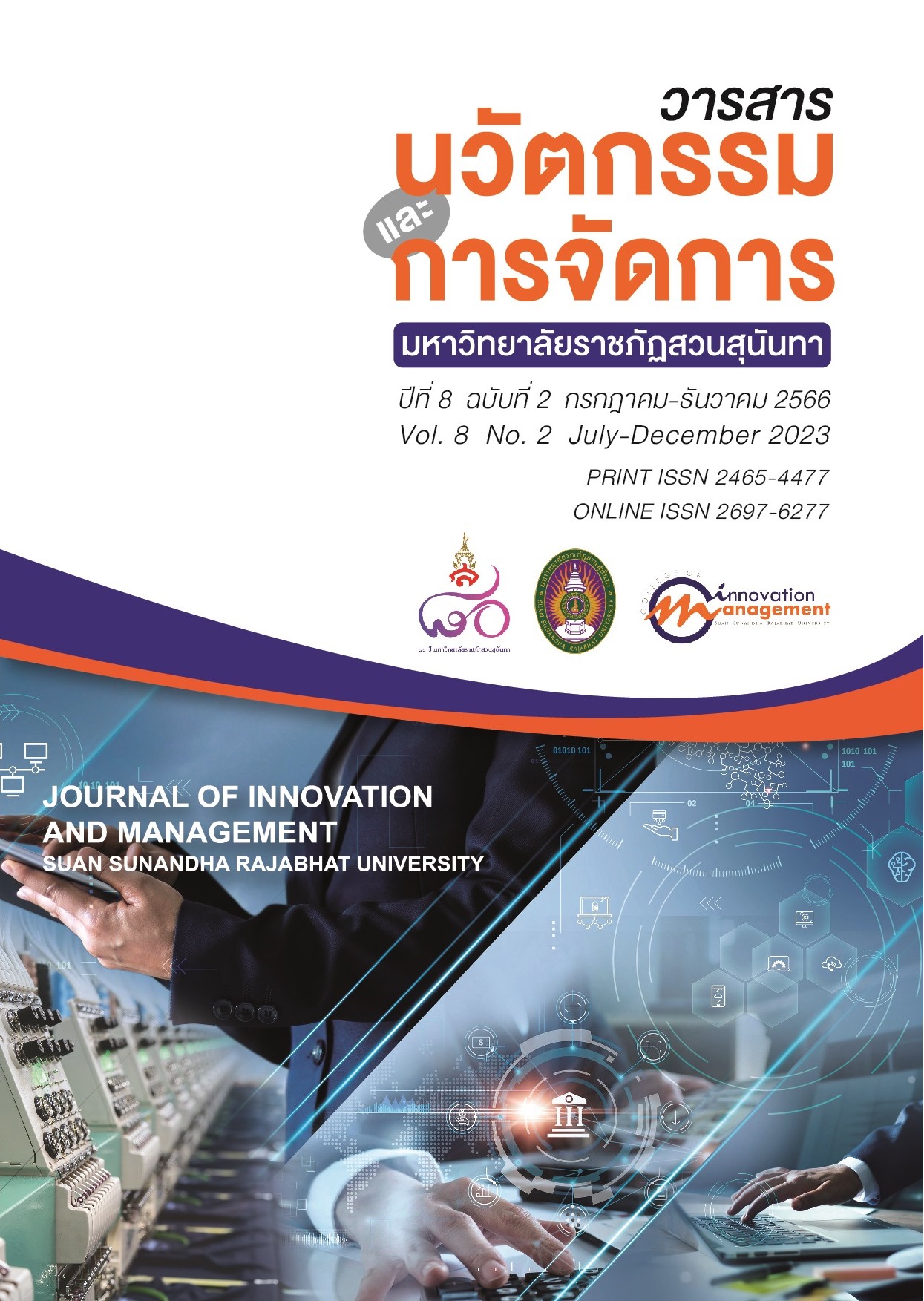The Influence of Quality and Credibility of Electronic Word-of-Mouth Information on Green Product Information Forwarding and Green Product Purchase Intentions
Keywords:
Electronic Word-of-Mouth, Information Quality, Information Credibility, Information Usefulness, Forwarding Information, Purchase IntentionsAbstract
The objective of this research is to develop and examine a causal relationship model. Also, it examines the direct effect, Indirect effect, and total effect between information quality, information credibility, information usefulness, purchase intention, and forwarding information on green products via electronic word-of-mouth communication in Thailand. The researcher used quantitative research and collected data by distributing questionnaires via green products online channels such as Facebook, YouTube, and Instagram platforms, which obtained data from 400 samples. Structural equation analysis from the structural equation model was consistent with the empirical research. The results of the hypothesis test found that information quality, information credibility, and information usefulness affect purchase intention and forwarding information about green products, which is significant at the 0.05 level. Moreover, information quality and information credibility have a direct effect on information usefulness and have an indirect effect on purchase intention and information forwarding. It was also found that information quality and information credibility have different effects on information usefulness, which depends on situations and study topics. In terms of green product information from electronic word-of-mouth communication in Thailand, it was found that information credibility affects information usefulness more than information quality.
References
Bentler, P. (1999). Cutoff Criteria for Fit Indexes in Covariance Structure Analysis: Conventional Criteria versus New Alternatives. Structural Equation Modeling, 6, 1-55.
Cheng, S. (2011). Comparisons of Competing Models between Attitudinal Loyalty and Behavioral Loyalty. International Journal of Business and Social Science, 2 (10), 149-166.
Chung, N., Han, H. and Koo, C. (2015). Adoption of travel information in user-generated content on social media: The moderating effect of social presence. Behaviour & Information Technology, 34, 1-18.
Erkan, I. and Evans, C. (2016). The Influence of eWOM in social media on Consumers’ Purchase Intentions: An Extended Approach to Information Adoption. Computers in Human Behavior, 61, 47-55.
Filieri, R. and McLeay, F. (2014). E-WOM and Accommodation: An Analysis of the Factors That Influence Travelers' Adoption of Information from Online Reviews. Journal of Travel Research, 53, 44-57.
Fornell, C. and Larcker, D. F. (1981). Evaluating Structural Equation Models with Unobservable Variables and Measurement error. Journal of Marketing Research, 18(1), 39-50.
Futurist NIDA. (2022). Awareness of the significance of environmental issues. (n.p.)
Gatzer, S., Helmcke, S., and Roos, D. (2022). Playing offense on circularity can net European consumer goods companies €500 billion. McKinsey Insights
Gvili, Y. and Levy, S. (2016). Antecedents of attitudes toward eWOM communication: differences across channels. Internet Research, 26, 1030.
Hair, J., Black, W., Babin, B. and Anderson, R. (2010). Multivariate Data Analysis.7
Kate, P. (2021, July 2). Thai consumers willing to pay more for ESG-linked products. PwC Thailand. [Online]. Retrieved from: https://www.pwc.com/th/en/press-room/press-release/2021/press-release-02-07-21-en.html
Kreis, H., and Gottschalk, S. (2015). Relating eWOM Motives to eWOM Channel Choice - Why Do We Post Where We Do?. Schmalenbach Business Review, 67, 406-429.
Kudeshia, C., and Kumar, A. 2017. Social eWOM: Does it affect the brand attitude and purchase intention of brands?. Management Research Review, 40(3), 310-330.
Loo, R. and Thorpe, K. (2000). Confirmatory factor analyses of the full and short versions of the Marlowe–Crowne Social Desirability Scale. The Journal of Social Psychology, 140(5), 628–635.
Marsh, H., Wen, Z. and Hau, K. (2004). Structural Equation Models of Latent Interactions: Evaluation of Alternative Estimation Strategies and Indicator Construction. Psychological methods, 9, 275-300.
Mahapatra, S. and Mishra, A. (2017). Acceptance and forwarding of electronic word of mouth. Marketing Intelligence & Planning, 35(5), 594-610.
Matute, J., Yolanda, P. and Utrillas, A. (2016). The influence of EWOM characteristics on online repurchase intention: Mediating roles of trust and perceived usefulness. Online Information Review, 40, 1090-1110.
Moslehpour, M., Aulia, K. and Masarie, C. (2015). Bakery Product Perception and Purchase Intention of Indonesian Consumers in Taiwan. International Journal of Business and Information, 10, 63-94.
Pintuma, S. and Aunyawong, W. (2021). The effect of green supply chain management practices on environmental, operational and organizational performances of seafood manufacturers in Thailand. International Journal of eBusiness and eGovernment Studies, 13(2), 33-48.
Pinturong, S. (2020). Attitude and Behavior Towards Green Marketing for Thai Consumer. Thesis of the Degree of Master of Management Program. Nakhon Pathom: Mahidol University. (in Thai)
Purnawirawan, N., Pelsmacker, P. and Dens, N. (2012). Balance and Sequence in Online Reviews: How Perceived Usefulness Affects Attitudes and Intentions. Journal of Interactive Marketing, 26(4), 244-255.
Rujirek Rasameechaturong. (2011). Cosmetic product recommendations on cosmetic websites. Bangkok: Chulalongkorn University.
Schiffman, L. and Kanuk, L. (2010). Consumer Behavior. 10th ed. Upper Saddle River, N.J.: Prentice-Hall.
Statista Research Department. (2022). Most popular social networks worldwide as of July 2022, ranked by number of active users (in millions). (n.p.)
We Are Social (2023). DIGITAL 2023: THAILAND. Kepios. [Online]. Retrieved 13 February 2023, from: https://datareportal.com/reports/digital-2023-thailand
Wixom, B. and Todd, P. (2005). A Theoretical Integration of User Satisfaction and Technology Acceptance. Information Systems Research, 16(1), 85-102.
Yeap, J., Joshua,I. and Ramayah, T. (2014). Determining consumers’ most preferred eWOM platform for movie reviews: A fuzzy analytic hierarchy process approach. Computers in Human Behavior, 31, 250–258.
Downloads
Published
How to Cite
Issue
Section
License
Copyright (c) 2023 Journal of Innovation and Management

This work is licensed under a Creative Commons Attribution-NonCommercial-NoDerivatives 4.0 International License.
See Publication Ethics https://so03.tci-thaijo.org/index.php/journalcim/Ethics






